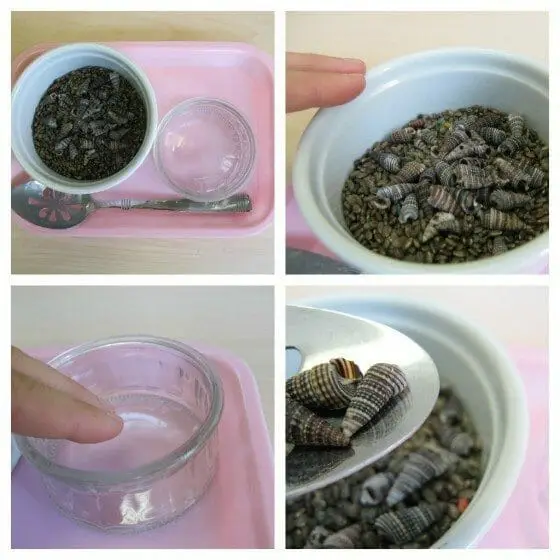Spooning is a Basic Exercise within the Practical Life area of a Montessori classroom. One of the first lessons introduced in the early childhood classroom, this work further develops focus, concentration, and visual and fine motor development.
The spooning work will also help a child master the three-finger grip and thus prepare him for activities outside the Practical Life learning area. This work is fantastic because there is a lot of creativity you can throw into the mix depending on the materials available, the interests of children, and themes throughout the year.
Children seem to enjoy transfer work, including the sounds, the objects, and the utensil. Plus, children work on their fine motor skills and pre-reading left-to-write skills.

What is the Spooning Activity in Montessori?
In Montessori education, “spooning” is a practical life activity designed to help young children develop their fine motor skills, hand-eye coordination, and concentration. It typically involves using a spoon to transfer small items (such as dried beans, rice, or beads) from one container to another. This seemingly simple exercise supports the development of muscle control in the hand, preparing the child for more complex tasks like writing.
The activity also promotes independence, as children learn to complete it on their own with minimal guidance. Additionally, spooning helps build a sense of order and precision, as children practice moving the items carefully without spilling.
It's often part of a sequence of exercises in the Montessori classroom that focus on practical life skills, such as pouring, scooping, and sorting.
In Montessori education, the spooning activity is a practical life exercise designed to develop a child's fine motor skills and promote independence in everyday tasks.
The activity involves using a spoon to transfer objects from one container to another, typically from a larger bowl to a smaller one.
What Age Group is Spooning Montessori?
Montessori education is typically divided into different age groups based on developmental stages. The specific age group associated with “spooning” activities is generally within the infant and toddler age group, ranging from 18 months to 3 years.
Spooning activities are part of the Practical Life exercises in Montessori, which are designed to develop fine motor skills, hand-eye coordination, concentration, and independence in young children.
This stage is where children work on transferring objects (like beans or rice) using a spoon from one container to another. It introduces them to basic skills that are foundational for more complex tasks as they grow older.

What is the Direct Aim of Spooning?
The direct aim of the spooning activity in Montessori is to develop and refine a child's fine motor skills, particularly focusing on their hand-eye coordination, wrist rotation, and precision in hand movements.
Through the spooning activity, children practice using a spoon to transfer objects from one container to another. This requires them to grasp the spoon with a proper grip, scoop the objects, and then transfer them to the target container. The direct aim is to help children gain control and coordination over their hand and finger movements, enhancing their dexterity and precision.
By engaging in spooning activities, children develop their pincer grip, which is the coordination of the thumb and the index and middle fingers. This grip is crucial for future activities such as writing, drawing, using utensils, and performing intricate tasks that require fine motor skills.
Additionally, the spooning activity promotes concentration, focus, and a sense of order as children work carefully and methodically to transfer the objects. It encourages children to move intentionally, observe the spatial relationship between the spoon and the containers, and refine their movements for accuracy.
The direct aim of the spooning activity aligns with the broader goals of Montessori education, which emphasize the development of independence, coordination, concentration, and orderliness. Through the direct aim of spooning, children develop foundational skills that lay the groundwork for various practical life activities and future academic pursuits.
What are the Steps of Spooning?
Practical Life Lesson
- Go to the shelf, remove the tray, and walk carefully to a table.
- Identify objects on the tray: “This is a bowl with objects in it. This bowl is empty. This is the spoon.”
- “Handle.”
- “Spoon.”
- Place the spoon in the dominant hand, holding out thumb and index finger in L shape and placing the handle in the cradle
- Grasp the neck of the spoon with the ends of the thumb and index finger.
- Turn and lift a spoon to gather beans or beads (from the left bowl).
- Move slowly above the empty bowl on right. Repeat the procedure until all beans have been transferred.
- Check to make sure all objects have been moved from left to right. Repeat, moving objects back to the original bowl.
A three-year-old educated according to Montessori pedagogy, becomes a master of his hand and undertakes with a joy a variety of human activities. These activities allow him to develop the power of concentration.
Dr. Maria Montessori
Spooning Lesson Variations

I adore this variation of sifting shells from grains.
The spooning activity not only fosters fine motor skills but also encourages focus, patience, and a sense of order. It allows children to practice and refine their hand control, preparing them for more complex tasks like pouring, stirring, and serving food.
As with other Montessori practical life activities, the spooning activity helps children gain independence by developing practical skills they can use in daily life. It also supports their cognitive growth, concentration, and self-confidence.
It's important to note that Montessori activities are introduced based on a child's individual readiness and progress, ensuring the materials and instructions are suitable for their age and skill level. The activities are designed to be engaging, purposeful, and tailored to each child's developmental needs.
Montessori Services has great Starter Sets available for purchase at a very reasonable price.
Best,
Marnie
